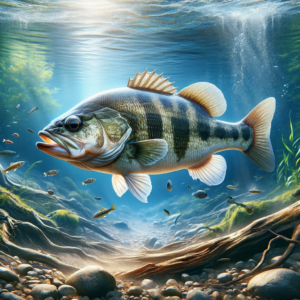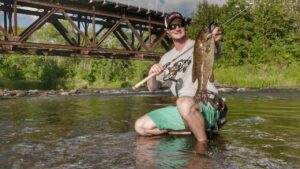Have you ever wondered about the feeding habits of smallmouth bass? These popular sport fish can be found in rivers and lakes across North America, and understanding what they eat can help you become a more successful angler. In this article, we will explore the diet of smallmouth bass in detail, looking at what they like to eat and how their feeding habits change throughout the year.
Smallmouth bass are known for their voracious appetites, but do they eat crappie? While smallmouth bass primarily feed on smaller fish, such as minnows and shad, they are opportunistic predators and will not hesitate to devour a crappie if given the chance. In fact, crappie make up a significant portion of the diet of larger smallmouth bass, especially in bodies of water where crappie are abundant. Smallmouth bass have large mouths and sharp teeth that are perfectly adapted for hunting and catching prey. They are known to be aggressive feeders and will often strike at anything that resembles a potential meal.
Understanding the feeding habits of smallmouth bass is crucial for anglers hoping to catch these prized fish. By knowing what smallmouth bass eat and when they are most likely to be feeding, you can choose the right bait and fishing techniques to increase your chances of success. In the next paragraphs, we will delve deeper into the diet of smallmouth bass, exploring the specific types of prey they prefer and how their feeding habits change throughout the year. Whether you are a novice or experienced angler, there is always something new to learn about the feeding habits of smallmouth bass.
The Feeding Habits of Smallmouth Bass
General Overview
Smallmouth bass, known for their aggressive nature and impressive fighting capabilities, are a popular species among anglers. Understanding their feeding habits is crucial for successful fishing expeditions. In this article, we will delve into the diet composition, preferred prey, feeding techniques, hunting patterns, habitat influence, seasonal variations, feeding in different environments, and their interaction with other species.
Diet Composition
Smallmouth bass possess a diverse diet, consuming a variety of aquatic organisms. While their feeding habits may differ depending on their environment, their diet primarily consists of small fish, insects, crustaceans, and various other invertebrates.
Preferred Prey
Among their preferred prey, small fish play a significant role in the diet of smallmouth bass. Crayfish, minnows, and sunfish are commonly targeted by these voracious predators. Insects, such as caddisflies, mayflies, and dragonflies, are also an important food source, particularly during certain times of the year.
Feeding Techniques
Smallmouth bass employ different feeding techniques to capture their prey. One of the most common techniques is ambush predation, where these fish hide near structures, such as rocks, logs, or vegetation, and swiftly attack passing prey. They also utilize pursuit predation, actively chasing down their prey in open water areas. Moreover, smallmouth bass are skilled at bottom feeding, foraging for food on the lake or riverbed.
Hunting Patterns
Smallmouth bass showcase distinct hunting patterns that vary depending on their environment and the availability of prey. In lakes, they often roam along drop-offs, ledges, and weed edges, searching for unsuspecting prey. In rivers, they commonly congregate near current breaks, such as boulders or submerged tree roots, to take advantage of the flow and ambush prey passing by.
Habitat Influence on Feeding
The feeding habits of smallmouth bass are greatly influenced by their habitat. They tend to focus their feeding activities in areas with appropriate cover and access to food sources. Rocky areas, submerged vegetation, and fallen trees create ideal hunting grounds for smallmouth bass, providing shelter for both their prey and themselves.
Seasonal Variations
Smallmouth bass display significant changes in their feeding habits throughout the year. During the spring, they are particularly active as water temperatures rise, and their prey becomes more abundant. In this season, they often target spawning fish, as well as newly hatched insects. During the summer months, their feeding becomes more opportunistic, targeting prey that is readily available and easily accessible. In the fall, smallmouth bass feed voraciously to build up energy reserves for the winter. As winter approaches, their feeding activity decreases, and they become less active overall.
Feeding in Different Environments
Smallmouth bass exhibit unique feeding behaviors depending on the environment they inhabit. In freshwater lakes, they often forage near drop-offs, submerged vegetation, and rocky areas, taking advantage of the diverse food sources available. In flowing rivers and streams, smallmouth bass are adept at navigating currents and utilizing structures to their advantage when hunting for prey.
Interaction with Other Species
Smallmouth bass play an essential role in the aquatic ecosystem and interact with various other species. While they are top predators themselves, they are also preyed upon by larger fish, such as pike and muskellunge. Smallmouth bass also compete with other species, such as largemouth bass and walleye, for food resources and suitable habitats.
Conclusion
Understanding the feeding habits of smallmouth bass is crucial for any angler looking to target this exciting species. Small fish, insects, crustaceans, and invertebrates form the core of their diet, while their preferred prey includes crayfish, minnows, and sunfish. Feeding techniques like ambush predation and pursuit predation highlight their adaptability and effectiveness as hunters. Habitat, seasonal variations, and the presence of other species all affect their feeding behaviors. By studying and adapting to these patterns, anglers can improve their chances of success when targeting smallmouth bass in different environments.




